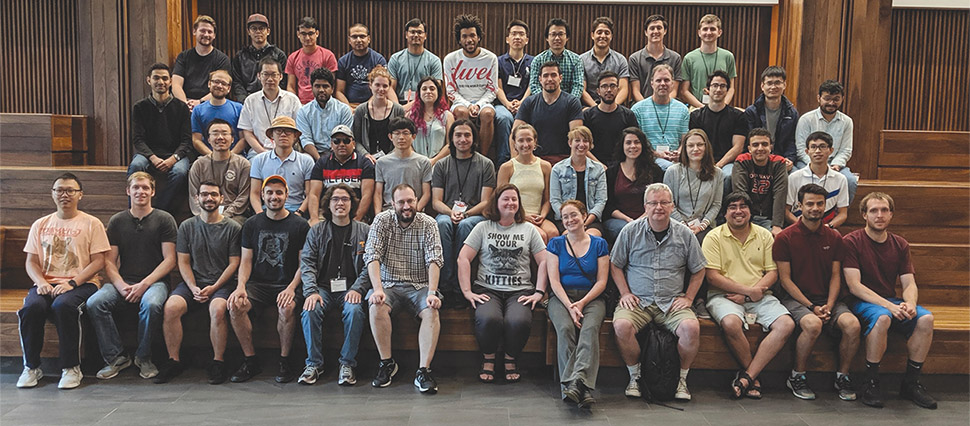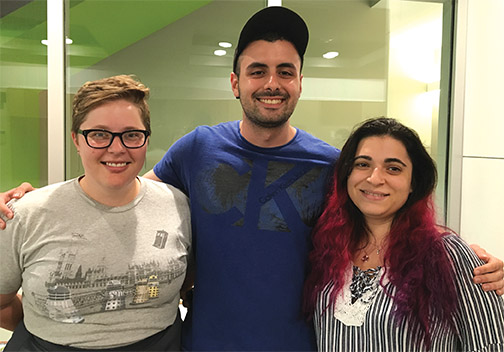Summer School: Nuclear Style

The 2019 National Nuclear Physics Summer School cohort and organizers.
They came from California and Texas and Florida; Kentucky and New Jersey. They came with different interests and backgrounds, but learned in 11 days what they have in common and how it’s possible to learn about physics and make friends for life at the same time.
The National Nuclear Physics Summer School, held July 8-19 and hosted by UT Physics, brought together roughly 50 graduate students and postdocs to learn how broad the field is and where nuclear physics research is headed.
Associate Professor Nadia Fomin served as the summer school’s host. She is well acquainted with this kind of professional responsibility: last fall she organized and hosted the Southeastern Section meeting of the APS (SESAPS) at UT. A mini-symposium she hosted on the neutron’s lifetime at an April APS meeting was featured on the Nature website. Earlier this year she was elected to the American Physical Society Division of Nuclear Physics Executive Committee. Her fellow summer school organizers included Assistant Professor Miguel Madurga and Associate Professor Christine Nattrass, as well as Charlie Rascoe of Oak Ridge National Laboratory.
Together they put together a program that drew on their areas of expertise but also served to represent the whole of nuclear physics to the young physicists in attendance. Among the topics were neutrino physics, fundamental symmetries, Bayesian analysis, the quark gluon plasma, and an overview of the physics program at Jefferson Lab.
"One of the goals is basically to expose the students to the research that is going on in our field right now and that they will be hearing about for the next 10 years," Fomin said. "It’s to give them a broad education in nuclear physics because their specific research will be very narrowly focused."

Michelle Gervais (University of Kentucky), Ibrahim Abdurrahman (University of Washington), and Stefania Dede (Texas A&M) were among the graduate students taking part in the National Nuclear Physics Summer School, hosted by UT Physics.
That approach clearly resonated with the students.
Michelle Gervais, a PhD student from the University of Kentucky, said the school gave students a wider view of the nuclear physics landscape. Her doctoral research is based at ORNL with the Nab Collaboration, an experiment dedicated to the detailed study of neutron decay via measurement of very specific correlations.
"I think sometimes we kind of pigeonhole ourselves" in sub-disciplines or individual research areas, she said. The summer school helps broaden their perspectives.
Ibrahim Abdurrahman is pursuing a doctorate at the University of Washington and attended the school on his advisor’s recommendation. The best part of getting this kind of overview, he said, is seeing how his work interconnects with all of nuclear physics.
"I just kind of want to understand where nuclear physics is," as a field, he said. He has worked in computational physics (specifically in theoretical low-energy nuclear physics) and he sees that experience as being adaptable to different research areas. "It also just motivates you to do research," he said of the summer school: it’s a way of "recharging."
The school itself was somewhat intense: speakers gave two or three lectures each and the presentations typically ran from morning through the afternoon. Lecturers often attended one another’s talks and when possible shared meals and spent downtime with students. The organizing committee made it a point to break up the schedule with other events, including a standing-room only public lecture on Chernobyl: Fallout, Facts, and Fiction*. A rafting trip and a tour of the ORNL Spallation Neutron Source rounded out the program with a balance of recreation and real-world research exposure. Stefania Dede, a doctoral student from Texas A&M, particularly enjoyed the latter.
"Lectures are okay," she said, "but let’s go to a lab" she said with genuine enthusiasm. "I like hands-on."
Students also came up with some spontaneous outings of their own.
Gervais is a self-described introverted extrovert who talked about the importance of camaraderie for students—something she has made it a point to encourage in graduate school. She said she enjoyed the time spent with other students, including an off-the-schedule Sunday trip to Fort Dickerson Quarry Lake for some swimming and socializing.
Dede is the point person for a 2020 Conference for Undergraduate Women in Physics (CUWiP) at Texas A&M and said that this experience not only helped her develop skills to organize a meeting, but also made it easier for her to connect with other students at the summer school, in collaborations, etc.
That’s one element that prompted a group of nuclear physicists to design the nuclear physics summer school back in 1987. The program has been held every year since with the exception of one summer and is sponsored by the US Department of Energy, the National Science Foundation, and the National Institute for Nuclear Theory at the University of Washington.
Fomin pointed out that it’s important to keep abreast of what’s going on in your field outside of your very specific research area and the summer school demonstrates that mindset to up-and-coming scientists.
"They’ll be going to national meetings—national nuclear physics meetings—and I hope that now they will be able to go to talks in every area and be able to understand them and get something out of them," she said.
That’s not the only important element, however, as the impromptu swim party demonstrated.
"There’s also a social aspect to it," Fomin said. "They’re at similar points in their education and careers; so they’ll be going through post-docs together, through faculty searches together, and it’s good to keep connections with people throughout your field. They basically made friends for life."
* Chernobyl: Fallout, Facts, & Fiction: The UT Office of Information Technology has made this public lecture webcast available on-demand at oit.utk.edu/news/webcasting-case-story-skutnik/